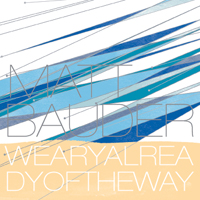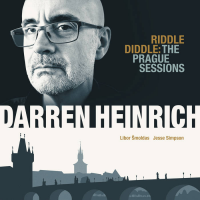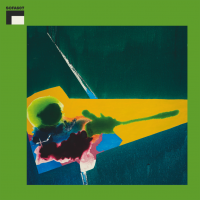Home » Jazz Articles » Multiple Reviews » Dynamic Duos
Dynamic Duos
This enables me to shoot down the standard complaints against jazz—“Isn’t it just a lot of noise?” “What exactly makes it sufficiently complex and cerebral for an intellectual such as myself?” “What makes it accessible and emotional enough for a pop fan like me?” “Sure, it’s okay for a bit of fun, I guess. But is it art?”—without having to think too rapidly on my feet and risk doing the cause more harm than good: just one of the factors which pushed me toward the paced, revisable process of writing instead of trying my hand at the more quick-witted lecture circuit.
Until recently, however, my list hadn’t given much direct consideration to the duo, a permutation of performer and instrument that seems to have found a more accommodating and auspicious home in jazz than in most other genres, with the possible exception of folk. (And with “duo,” I use the word in its purest sense, not to mean “two vocalists/rappers supplemented by backing orchestration/beatbox” or “famous guitarist and famous singer appearing together with studio band.”)
More specifically, what struck me was the way that jazz duos can produce such radically disparate sounds among themselves, unlike the way, say, five boy pop singers always sound like five boy pop singers, or a four-handed piano repertoire inevitably sounds like a four-handed piano repertoire. Let me lay on the table two new albums to corroborate this claim. The first is Come Sunday by Assif Tsahar (tenor sax, bass clarinet) and Tatsuya Nakatani (percussion); the second is Pictures of Soul by Omar Sosa (piano) and Adam Rudolph (percussion).
 Assif Tsahar & Tatsuya Nakatani
Assif Tsahar & Tatsuya Nakatani
Come Sunday
Hopscotch Records
2003
Come Sunday is music that on its most immediate, most obvious level is meant to conjure an ostensibly non-musical vignette in the mind’s eye. Think of Clifford Brown & Max Roach’s “Parisian Thoroughfare” or Beethoven’s sixth “Pastorale” symphony. Within its 52-minute running time, Come Sunday contains several such items. The sound of waking from a mid-afternoon nap to the sound of gentle rain. The sound of sitting in rush hour traffic. Of watching one of life’s comedies play itself out through a greasy diner window. Of hearing one side of a frantic phone conversation. From start to finish, Come Sunday is free, loose, broadly expressive, impressionistic.
And yet, for all its moments of discord, not one threatens the organic, almost telepathic dialogue between these two musicians. Tsahar and Nakatani maintain an impressive unity that is rarely possible among larger incarnations like trios, quartets and philharmonic orchestras. As if to demonstrate the power of the jazz duo (their own in particular), they have given us the title track, a Duke Ellington chart originally composed for a much larger ensemble, in addition to their ten original compositions.
Not everything on Come Sunday is sheer bliss. “West 4th” overlooks the fact that Coltrane, whose influence haunts Tsahar’s playing on this disc, never abandoned a solid melodic line altogether to chase after rapture. “Street Cleaning” is a bit too much like performance art. It’s also tempting to wonder where “Circling the Cube” is headed, and why. But you can be sure that wherever Tsahar is going, Nakatani is right beside him; and vice versa. I doubt that even Siamese twins share this kind of intimacy.
 Omar Sosa & Adam Rudolph
Omar Sosa & Adam Rudolph
Pictures of Soul
Otá Records
2004
Such intimacy is in notable contrast to Omar Sosa’s and Adam Rudolph’s Pictures of Soul — or at least the one track I’ve been unable to push out of my head, “The Call.” Here Sosa plays on the piano a slow, pensive, poignant tune, one which requires by its very nature an atmosphere of solitude and silence. Suddenly Rudolph raises an absolute ruckus, with all the grace and musicality of stumbling over a child’s toybox. The disruption lasts only a few seconds, but it’s enough to spoil the mood of the piece completely. More confusing still, “The Call” is one of two songs on the album wholly penned by Sosa (the other being the equally atmospheric but undisturbed “Winter of the Flower”), implying that the ruckus is in line with the composer’s wishes. Perhaps Sosa—more renowned for his septet and octet work—was simply delighting in creating an effect in order to destroy it.
Like meeting a beautiful woman with parsley between her teeth, these few peculiar, unsettling seconds embedded themselves so deeply in my first impression of Pictures of Soul that I subsequently had to work to prevent them from marring my overall opinion of such a wondrous, moving album. It takes an exercise of willpower to erase it from memory when listening to the subtle shadings of “Portait,” the mysterious and rather minimalist “The Wandering Night,” or the tropical frolicking of “Kiss of the Rain.”
Or is that missing the point? Instead of reading the mood-shattering outburst in “The Call” as some sort of anomaly, might it be somehow indicative of Sosa and Rudolph’s intent? Put another way, whereas the relationship between Tsahar and Nakatani is a complementary one, each operating in conjunction with the other as they aspire toward transcendence, the relationship between Sosa and Rudolph is antagonistic, each building against the other toward the same goal. Their music is not so much dialogue as it is dialectic. Thus we have not a lack of intimacy, but a different variety of intimacy. I would even assert that the latter is more difficult to sustain: Rudolph or Sosa has to understand what his partner is doing so fully that he might perform the opposite.
This, then, is the magic of the jazz duo. The intrinsic distinction isn’t that Sosa is a pianist and Tsahar opts for woodwinds, though this no doubt shapes their respective sounds; it’s in the way that Tsahar works closely with Nakatani and Sosa works closely with Rudolph. In spite of their similarities in makeup, these are two fundamentally different groups comprising fundamentally different musicians who have in turn created two fundamentally different albums. Tsahar and Nakatani’s Come Sunday is urgent, abstract, but still rooted in scenes of contemporary reality. Sosa and Rudolph’s Pictures of Soul is more melodic, introspective, and inclines toward the spiritual.
My personal opinion is that Pictures of Soul will prove the more enduring, and is consequently the better album of the two under review, but that does not mean that Come Sunday fails to make an excellent counterpart. If I have endeavored here to make one point at the expense of all others, it’s that jazz allows excellent things to come in twos.
Find out more about Assif Tsahar and Tatsuya Nakatani by visitng Hopscotch Records online. Find out more about Omar Sosa and Adam Rudolph by visiting Otá Records .
Tracks and Personnel:
Come Sunday
Tracks: Rap Act Slot; J Walk; Closed News; Sawing Clouds; Street Cleaning; Come Sunday; West 4th; NY Moment; Low Lov; Circling the Cube; Missed Rehearsal.
Personnel: Assif Tsahar - tenor sax and bass clarinet, Tatsuya Nakatani - drums and percussion
Pictures of Soul
Tracks: Portrait; The Call; Kachirumba; Eye of the Blackbird; Dreams; The Wandering Night; Cuzco Refrain; Intermezzo; Trace of Burning Stars; Green Silence; Winter of the Flower; Sweet Summer; Serenade for Two; Kiss of the Rain; Pilgrimage; Black Exit.
Personnel: Omar Sosa – piano, Fender Rhodes, Harmonium, Adam Rudolph – congas, djembe, tarija, dumbek, gongs, udu drums.
Tags
PREVIOUS / NEXT
Support All About Jazz
 All About Jazz has been a pillar of jazz since 1995, championing it as an art form and, more importantly, supporting the musicians who make it. Our enduring commitment has made "AAJ" one of the most culturally important websites of its kind, read by hundreds of thousands of fans, musicians and industry figures every month.
All About Jazz has been a pillar of jazz since 1995, championing it as an art form and, more importantly, supporting the musicians who make it. Our enduring commitment has made "AAJ" one of the most culturally important websites of its kind, read by hundreds of thousands of fans, musicians and industry figures every month.

















